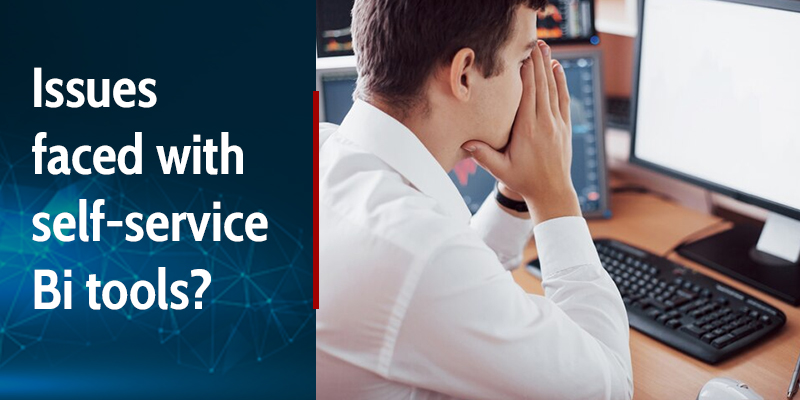In the present era, having right information at the right time is a key to run a successful business & drive its growth. However, this is the precise challenge many businesses face – inability to get all critical information at one place and make sense of it. Most companies have data but not information which can be converted to drive powerful decisions. And the complexities increase when the data is scattered in multiple systems and documents. Worse, there is a lot of data which beg to be captured but are ignored as they are not critical for managing day-to-day tasks.
“Most of the world will make decisions by either guessing or using their gut. They will be either lucky or wrong.”
– Suhail Doshi
This is where a good business intelligence solution can help companies. An ideal BI solution should let the leaders know:
- Where are we? What is happening today?
- Is what is happening in line with what is desired?
- What decisions need to be made to change the current state?
BI can be built using powerful tools and there are multiple softwares available as DIY tools in the market. These tools help you make very good charts and analysis but unfortunately these tools need technology and functional experts to design and implement a complete and powerful reporting and analysis solution.
Self-service BI promises data democratization and faster data-based decisions, but it’s not without limitations. Self-service BI is a powerful tool, but like all tools, it can be underused, especially by people lacking proper training. A company may invest in a tool but many times they miss out on investing in the right expertise in getting the outcome expected of a BI solution. To realise the true potential of BI, you need functional experts who can understand the key metrics critical to the organisation, organise data, and train employees in maintaining data discipline. Organisation also need to invest in tech experts to ensure that their data in various systems are seamless integrated with the BI tool and to access information on a click.
This is the precise reason that organisation need an Assisted BI solution and not just a self-service tool. In an assisted BI, organisation need not spend any time or energy in getting the best results out of the BI. BiCXO is one such assisted BI solution.
Most articles focus on the benefits of self-service BI without looking at potential downsides that companies need to watch out for, including
-
- Licensing costs –
It is too expensive and hard to justify the ROI of BI
- Licensing costs –
Budgets and resources are tight everywhere but especially for small businesses. The existing Bi offerings, which are predominantly self-service Bi tools, are either expensive to the likes of SMEs or required additional investments to design, integrate & deploy the final solution. Thus, the total cost of ownership of the Self-service Bi Tools is too high.
-
- BI strategy not clearly defined
Without a clearly defined data-driven strategy, you are shooting in the dark. While implementing BI today’s entrepreneurs or business leaders often overlook this & there is a severe lack of strategy behind these insights.
-
- All-out data anarchy – Lack of company-wide adoption
Disjointed BI practices and failed universal adoption is a key business intelligence challenge. It’s essential to gain buy-in from all stakeholders early on in the process to get everyone on the same page.
-
- Analysing data from different systems or multiple data sources
No matter the size of the organization the problem is that data is often spread across a variety of different systems and software due to which getting the information you need can be an arduous task which is the biggest challenge
-
- Lack of commitment.
The unwillingness to make a long-term investment and an organizational commitment to trusted data stores and governed metrics, and the reluctance to dismantle shadow IT organizations.
-
- Data security.
Protecting data sets that reside on mainframes, servers, workstations, and everywhere in between—as well as identifying, isolating, and obfuscating PII, HIPAA, and other types of personal information while at rest, in use, and in flight.
-
- Data quality and consistency.
Important data are buried deep into systems, applications, and platforms which often get lost or missed as a result. BI-centric systems and sources delivering poor, inaccurate, and convoluted data-driven insights that ultimately waste time and money while stunning progress.
With the arrival of Assisted BI Solutions like BICXO the organizations can easily overcome the above challenges of self-service BI tools & thereby implement a robust BI solution in the organization with the help of the techno-functional expertise offered as part of the package. This acts as your in-house, MIS function, with completely automated business intelligence solution, where you can track your financial and operational metrics and do lots more with a click of a button without any restriction on the number of users & with no upfront investment; everything is covered in a monthly fixed fee.
Quick comparisons between Assisted BI solution vs self-service BI Tools will help drive the point.
| Features | BiCXO (Assisted Bi Solution) |
Self-service Bi Tools |
|---|---|---|
| Charts (Bar, Pie, Gantt, Donut, Maps etc.) |
Yes | Yes |
| Drill Down Feature | Yes | Yes |
| Web & Mobile access | Yes | Yes |
| User based Access | Yes | Yes |
| Functional analysis & data modeling |
Yes | No |
| Dashboard designing | Yes | No |
| Data gap analysis | Yes | No |
| Integration with other systems |
Yes | No |
| Continuous customization | Yes | No |
| Implementation support | Yes | No |
| Ongoing functional & technical assistance |
Yes | No |
Realizing that self-service BI isn’t a panacea is a great start. Beyond that level of self-awareness, the solution is hardly surprising.

